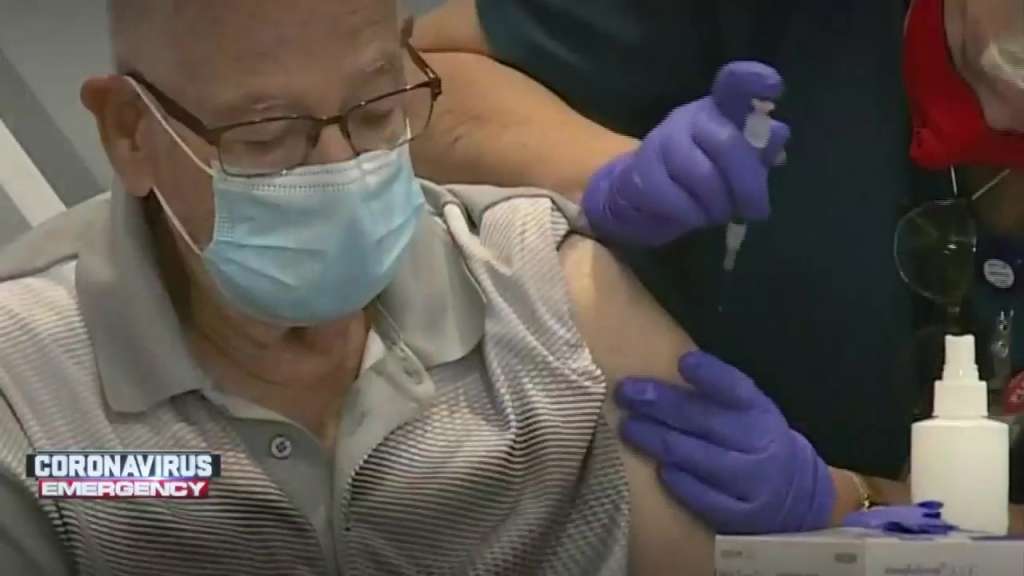Gov. Ned Lamont said staff and residents at all of Connecticut’s nursing homes are on track to have their first dose of the COVID-19 vaccine by Friday, but he acknowledged some workers have been reluctant to get the shot.
The state plans to begin airing a public service announcement on Tuesday, hoping to encourage more workers to get vaccinated.
“I am told that the overwhelming (number) of the (nursing home) residents are eager to get the vaccine and are getting vaccinated,” Lamont said. “I understand there’s a little more hesitancy when it comes to some of the nurses. Most are getting it, but not all. So we’re doing a pretty aggressive public outreach campaign to address them.”
Lamont said as of Monday, more than 75,000 of the 167,00 doses Connecticut has received so far have been administered. He said some “first tier responders” were getting their second doses on Monday, while residents and staff at some assisting living facilities were getting their first ones. He said Connecticut is among the first eight states that have administered the vaccine to more than 2% of the population.
Eighty-five sites across the state are now administering vaccine doses, including hospitals and nursing homes, with plans to roll out to pharmacies over the next couple weeks.
“So as we broaden our population, it’ll be easier for people to get their vaccine on a retail basis right at their local pharmacy, Walgreens, CVS, you name it … federally qualified health centers,” he said.
To prevent vaccine from “just sitting on a shelf and not being used,” an issue that has cropped up in other states, Lamont said the state has developed a “just-in-time inventory” system where unused doses of vaccine are transferred to other facilities at the end of the day.
Lamont said as Connecticut receives more vaccine from the federal government, state officials will “open up the lens a little bit more, either in terms of age groups, demographics or other front line responders to make sure that every drop of that vaccine is administered on a timely basis.”
“I don’t want to leave anything to chance, and I don’t want to leave anybody behind,” said Lamont, who hopes all “first tier folks in the health care and nursing homes” will have had their second vaccine by late January.
Lamont’s vaccine distribution advisory committee is scheduled to meet Tuesday. They’re expected to discuss who will be part of the Phase 1B distribution.
Since Saturday, there have been more than 4,500 new probable or confirmed COVID-19 cases in Connecticut; 55 more hospitalizations, for a total of 1,111; and 69 more COVID-associated deaths, for a total of 6,168.
In other coronavirus related news in Connecticut:
The leader of Connecticut’s largest teachers union is urging school superintendents statewide to switch all classes to remote learning until at least the middle of this month, citing concerns about the coronavirus pandemic.
Jeff Leake, president of the Connecticut Education Association, said many students and educators were to return to classrooms on Monday, before potential virus surges from the holiday season are over. He said many school districts already have moved to all-distance learning through mid-January.
“While no one is more eager to return to the classroom than Connecticut’s dedicated teachers, detecting and stopping the spread of COVID-19 must be the top priority,” Leake said in a statement Sunday evening.
Leake also called on the state to mandate more COVID-19 testing and said a new survey by his union and the American Federation of Teachers shows “schools are not the safest places for children or educators” amid a pandemic.
Lamont and state education officials have been allowing local school officials to decide whether to switch to all-remote learning but have been advocating for schools to be kept open, saying it’s better for students.
Since the school year began, nearly 8,500 students and 3,600 educators in Connecticut have tested positive for the coronavirus. The state has 528,000 public school students and 52,000 educators. Infections have declined over the past few weeks, which included holiday vacations.
Leake noted that 162 of Connecticut’s 169 cities and towns have been labeled by the state as coronavirus red alert zones, meaning they have averaged 15 or more coronavirus cases per 100,000 population a day for the past two weeks.
(Copyright (c) 2024 The Associated Press. All Rights Reserved. This material may not be published, broadcast, rewritten, or redistributed.)

